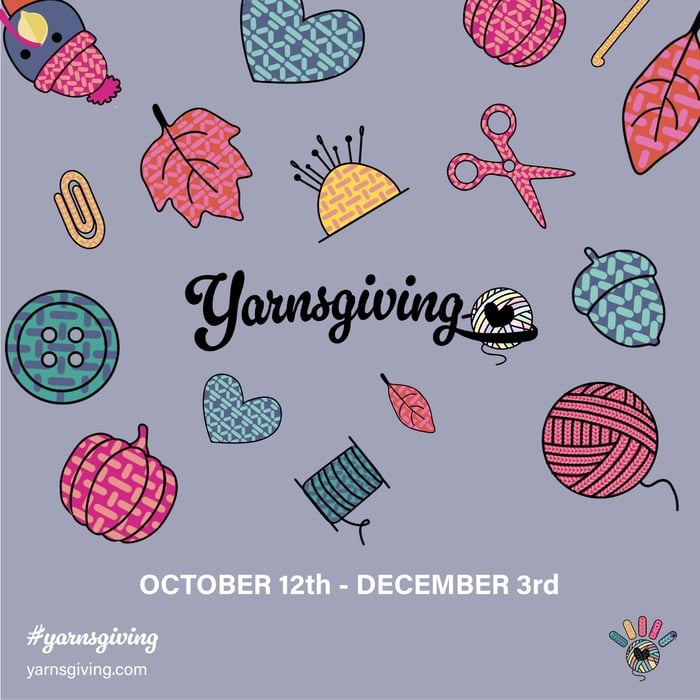Our Blog


Artist Spotlight: Round Mountain Fibers
We have an artist spotlight for you from Monica MacNeille, the owner of Round Mountain Fibers, a new line of yarn that we have added. We have asked Monica some questions to get to know her better!

Monica and her team.
What first got you into fiber art? Tell us your fiber art life story!
My mother is from Colombia, and she is an incredibly talented and meticulous fiber artist. Her mother, my Abuelita, was an accomplished seamstress. Despite growing up and living in a small town in Santander, Colombia, she drew her inspiration from fashion magazines from Paris. My mother was one of 16 children; 12 girls and 4 boys. She grew up learning to do everything my grandmother knew how to do. She was an accomplished seamstress, she embroidered, did cross-stitch, made elaborate macrame plant hangers (I was born in 1979), and she knit and did crochet. She made everything I wore as a kid, from knitting our underclothing in super soft thin cotton thread, to making socks and sweaters and dresses and everyday clothes. She taught me to crochet when I was very young. I was a very active kid and spent as much time as I could outdoors collecting rocks and shells and taking in orphaned animals and learning about plants and climbing trees. My favorite thing growing up was going to the beach and spending hours searching for interesting wildlife in tidal pools and for shells and creatures in the sand. I lived in Ecuador, Costa Rica, Honduras and Peru. My father worked for non-profits (he’s a Sociologist) and so I got to go to a lot of interesting places and we spent a fair amount of time around biologists and botanists and traveling to remote places. I moved back to the US to go to college at Marlboro College, in Southern Vermont.
Nature and the natural world is obviously a big inspiration for you. Do you start with the natural element in mind and go from there or do you have an idea for color ways and try to match it with a natural element?
I always start with inspiration from nature. When I first started Round Mountain Fibers I started with the Ornithology Collection, and designed colorways inspired by birds of North America. When I started our LYS Exclusive clubs, I began adding in birds from my childhood, and then branched out to birds from around the world. Each of my new collections started out as an LYS Exclusive club, so over the years we added the Entomology, Botany, Aquatic and Geology collections to our Featured Collections. In June/July of this year we will be adding our Herpetology and Mammalogy colorways to Featured. There are so many different ways to interpret a plant or animal!
You utilize many different dye methods. How do you decide how a certain color way will be dyed?
Our first two collections (Ornithology and Entomology) were dyed in our pooling/striping method. I really wanted to add speckles to my colorways, and started adding those in my LYS Exclusive clubs. At some point I started the Fan Club, a subscription where customers help me design a Fan Club exclusive colorway and coordinating semisolid every month. Fan Club allowed me to experiment with new methods and a wider variety of inspirations. Today, our Featured Collections are each dyed in a specific method: Ornithology and Entomology are pooling and striping, with Entomology featuring more stark contrast and typically a brighter palette than the Ornithology Collection (although we do have the occasional outliers). When we developed our Botany Collection, we decided to go with a Variegated method, where we zigzag the dye on the skeins so there is no pooling or striping. Our Aquatic Collection features Speckles. Our Geology Collection is dyed in what we call our Pop of Color method, with most of the skein semisolid and a pop of color at one end of the skein. Our Herpetology collection features what we call our Nebula method, where we dye one side of the skein in a semisolid, and the other side pooling/striping and with speckles. The Nebula method was something we came up with in Fan Club, when trying to capture the spirit of the Veil Nebula. Our Mammalogy Collection features our Watercolor method, which involves pours of color into a water bath to give a more watercolor effect (again with minimal pooling/striping).
We used to offer a coordinating semisolid for every one of our colorways, so when we launched the Aquatic and Geology collections, we dyed the coordinating semisolids in a tonal method. We’ve recently switched to offering just 1 coordinating semisolid (in both methods) for our LYS Exclusive clubs as it’s getting harder and harder to come up with unique semisolids every month! As of today, we offer over 775 different colorways, and roughly 325 of those are semisolids. We’ve been in business for 8 years now, and are adding over 100 new colors to our offerings every year (with a minimum of 8 new colorways per month between LYS Clubs and Fan Club).
What are some of your favorite color ways?
Oooh, that’s a hard question! At the moment I’m drawn to moodier, darker colors, and neutrals, but then again, I also love really unusual bright color combinations. My current favorite method is probably the nebula method of the Herpetology collection… with Watercolor as a close second, but those are our newest methods so obviously they are exciting to me right now.
What are some color ways/inspirations that didn’t make the cut?
None, really… I suppose we avoid colorways that look like ones we’ve done in the past, but again, as my colorways become more nuanced and complex, the only limit to finding inspiration in a colorway is the time crunch. If I’m really struggling with a colorway and I don’t love how it’s coming out, I’ll set it aside for later, so there are some I just haven’t revisited. In our most recent Fan Club we used the same inspiration and dyed it in all 5 methods!
What does a typical day in your studio/dye shop look like?
I’m not a morning person, so I wake up when my husband brings me coffee, and I’ll sit up in bed and check emails, print orders (my studio is in the basement of our home) and come up with a to-do list for the day. Molly arrives first, and when she pulls in the driveway Poppy (the larger of our Studio Dogs) gets really excited and demands that I get up. Bunny the Studio dog is still under the covers, and yawns and stretches and comes out of the covers, not quite ready to face the world. At around 10am Diana pulls in and Poppy is adamant that we go downstairs to say good morning. Molly is our principal Dyer, so she’s soaking yarn for the day’s queue, and coming up with a plan for her day. Diana starts by skeining and labeling the yarn we dyed the day before, and pulling and packing orders. I come down and read and respond to emails and go through social media answering questions and adding things to my to-do list. Our studio is quite small, around 900 square feet. Between Molly, Diana, myself and the two dogs it’s a fun and sometimes chaotic scene. We laugh a lot, and talk about everything under the sun while we work. The dogs do their best to get in the way, and “help”.

We carry both fingering and worsted weights of their yarn in 12 unique colorways!
Round Mountain Fibers Spruce Fingering Yarn

$34.00
Round Mountain Fibers Spruce Fingering Yarn Grown and spun in the US, Spruce Fingering is a 3-ply, hand-dyed 100% Superwash Merino yarn with a high...… read more
Round Mountain Fibers Willow Worsted Yarn

$34.00
Round Mountain Fibers Willow Worsted Yarn Willow Worsted is a 4-ply, hand-dyed 100% Superwash Merino yarn offering a nice hand and drape. This hand-dyed yarn is...… read more



